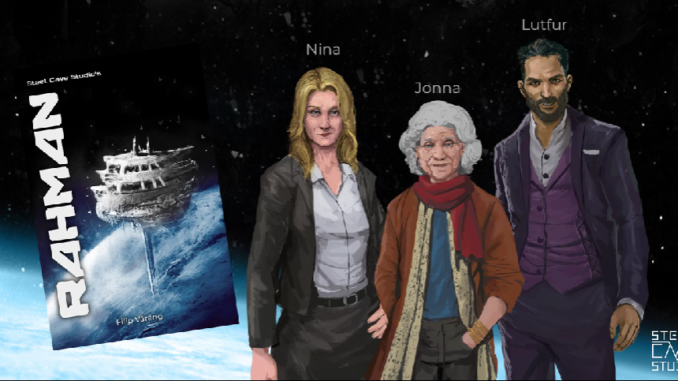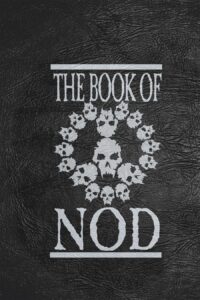
In the first part of this three-part article, I looked at one of the elements of RPGs lost to time and diminishing returns: Lines of prose fiction. At one time, a staple of the industry, a marker as to how successful an RPG was, these paperbacks and hardcovers are a footnote in history with only a few pieces of fiction continuing today. With a few fun options for what might be created in new lines of fiction teased in the last article, it’s time to get down to brass tacks, what would making new lines of fiction look like from the publisher’s and the author’s position. Everyone has to eat, that’s a given, so assuming good faith from both sides, what would the making the sausage aspect of creating new prose fiction be like? In this article, we’ll breakdown how prose could benefit the publisher and the author.
MONEY
Why haven’t any publishers taken on a line of fiction? Heck, maybe a “line of” is too much. But why hasn’t any of them taken up a pilot book, a single test novel to see if this is a viable idea or not? The sad truth can be summed up in a single word: Cost. Why hasn’t an indy creator/publisher with a hot game done the same? Time constraints. Writing a prose novel is as hard or harder than writing an RPG rulebook. It takes talent, eats time, and both of those have a price tag. For publishers, that cost is physical money paid. For writers, it’s time invested. I imagine both have contemplated the Fiction section of Kickstarter and had pause. Typically, one hundred fiction projects are campaigning at any time. Well under 10% reach $10,000.
 I’m going to hop down a bunny trail and pick a dollar amount for doing a fiction book. I’m drawing an artificial line in the imaginary sand of this musing by saying $10,000 is the minimum goal for a book. I reached that number by some back of the napkin math based on wild assumptions. It’s less than half of what a publisher and author really need, but it is enough to start the project with the hope of profitability in the long run. But, let’s break this down.
I’m going to hop down a bunny trail and pick a dollar amount for doing a fiction book. I’m drawing an artificial line in the imaginary sand of this musing by saying $10,000 is the minimum goal for a book. I reached that number by some back of the napkin math based on wild assumptions. It’s less than half of what a publisher and author really need, but it is enough to start the project with the hope of profitability in the long run. But, let’s break this down.
Assumption the first, the book is going to be 100,000 words. I choose that for its roundness and nice heft. To Kill a Mockingbird, The Hobbit, and Harry Potter and the Prisoner of Azkaban are all around 100,000 words, so that felt like a fair total.
Assumption the second, the author takes $.08 a word. Science Fiction Writers of America puts their 2019 minimum rate for short fiction at $.08 per word. Then you’ll need an editor, they’re going to need a few cents a word for their work, the minimum is $.04 a word based on some research, but it goes up from there. In terms of other expenses, there’s the cover art (rates range depending on if you want a unique, original cover or stock artwork), printing the book (if you decide on physical copies), fulfillment, overhead and, of course the publisher’s take. If you’re a publisher or self-publishing, you can play with those numbers, but a safe minimum for this article would be $10,000 for the creative side of the project and that again for the publisher’s work (overhead, printing, and shipping). If you’re doing your math with with the rest of us, then here’s what we have: $10,000 minus 10% for crowdfunding and transaction fees puts us at $9,000 minus $8,000 to the author leaves $1,000 for editing, cover art, printing, fulfillment, overhead, and taxes. In other words, these numbers don’t work if you only consider Kickstarter. There would be exceptions for a property with a loyal fanbase or a novel written by a beloved author, but that’s pumping up your funding potential, it doesn’t lower your expenditure. For most of this projects, to make them work, the missing balance would need to be made up by post-crowdfunding sales.
Assumption the third, that the publisher has deep enough pockets that they can keep the lights on while those additional funds come in through traditional and convention sales. At a guess, the publisher needs to reach $20,000 in sales via crowdfunding and post-crowdfunding purchases to break even. After that point, they see profit and can pay out any royalties. That’s the rub, the numbers are difficult and, considering the low percentage of fiction campaigns which reach $10,000 or more (less than 10% for fiction versus 25% to 30% for TTRPGs), hard to get enthusiastic about.
But, for this, let’s assume that you’re a publisher looking at the long tail and prepared to invest, to see if fiction is back and you can build it into a new revenue stream. Let’s be real, if you’re generating pulp or poorly affiliated products, your odds are long. However, if you’re leaning into a Book of Nod style book for MÖRK BORG, Mothership, CY_BORG, or the like (as discussed last article), then there’s a real possibility, especially if you’re able to combine that product with a creator that matches the style and has a growing fanbase. In other words, if you can lightning in a bottle, then you should lightning in a bottle. On the face of that idiom, you can see how unlikely the odds are.
ALTERNATIVE? 
Is there an alternative? Is there some other option to get you from reminiscing about how cool fiction was to a full line? There are, but these are more work intensive or less ethical, so take these with that grain of salt.
First, you could write it yourself. There’s no per word rate if you do it as opposed to hiring a freelance author. Second, you could pay less per word upfront, but make the royalty more generous. Third, community content via DriveThruFiction. This is one of the more overlooked options. DriveThruRPG, the DMsGuild, the Storytellers Vault, and Pathfinder Infinite offer a variety of community content programs in which creators can generate and sell original RPG products using aspects of a copyrighted IP. A similar program via DriveThruFiction combined with active editing and promotion would serve the same purpose, but remove the cost of production from the publisher’s shoulders. This model would see authors write what they chose, the publisher would give the products some degree of review and support in the hopes that one breaks out. In this hypothetical situation, one of the authors generates content that gains an audience, the publisher then picks them up, puts them on a contract, and they do a traditional publication of the book, likely via crowdfunding. For this, the Storytellers Vault and Onyx Path Publishing or Green Ronin/Nisaba Press and the AGE Creators Alliance would have the easiest go of it. They have existing infrastructure to place worthwhile fiction. They just need the fiction to place.
WHILE WE’RE ON THE SUBJECT
 As we’re discussing this, tabletop card game, Orbital Conflict, is kickstarting a 36,000 word novella about their universe. Written by Filip Våräng with a cover by Kim Astor, this book follows three entrepreneurs struggling in a cosmic tale. As of this writing, the book is in the Tabletop Games section of Kickstarter instead of the Fiction section. Yet, it’s struggling to reach its tame goal of SEK 10,000, around a $1,000 US. This is a good example of the struggle to create fiction from tabletop games. But, it also illustrates the value as Steel Cave Studio is pushing forward with this.
As we’re discussing this, tabletop card game, Orbital Conflict, is kickstarting a 36,000 word novella about their universe. Written by Filip Våräng with a cover by Kim Astor, this book follows three entrepreneurs struggling in a cosmic tale. As of this writing, the book is in the Tabletop Games section of Kickstarter instead of the Fiction section. Yet, it’s struggling to reach its tame goal of SEK 10,000, around a $1,000 US. This is a good example of the struggle to create fiction from tabletop games. But, it also illustrates the value as Steel Cave Studio is pushing forward with this.
Rahman: An Orbital Conflict story from Steel Cave Studio
End Date: Wed, August 3 2022 6:57 AM EDT.
“A stand alone, sci-fi, companion novella set in the same universe as our tabletop card game Orbital Conflict.”
WHAT’S TO COME?
In the final part of this series, I’ll look at the reasons why this debt might be desirable. Why prose fiction and some unrealized profits could lead to a bigger paycheck down the road. In other words, looking more at the long tail. If fiction lines return, what RPGs would inspire one-offs or full lines of fiction?
I wrote a few paragraphs for one of the Rex Draconis RPG books. Egg Embry participates in the OneBookShelf Affiliate Program, Noble Knight Games’ Affiliate Program, and is an Amazon Associate. These programs provide advertising fees by linking to DriveThruRPG, Noble Knight Games, and Amazon.
Latest posts by Egg Embry (see all)
- New Gamemaster Month 2023 - January 20, 2023
